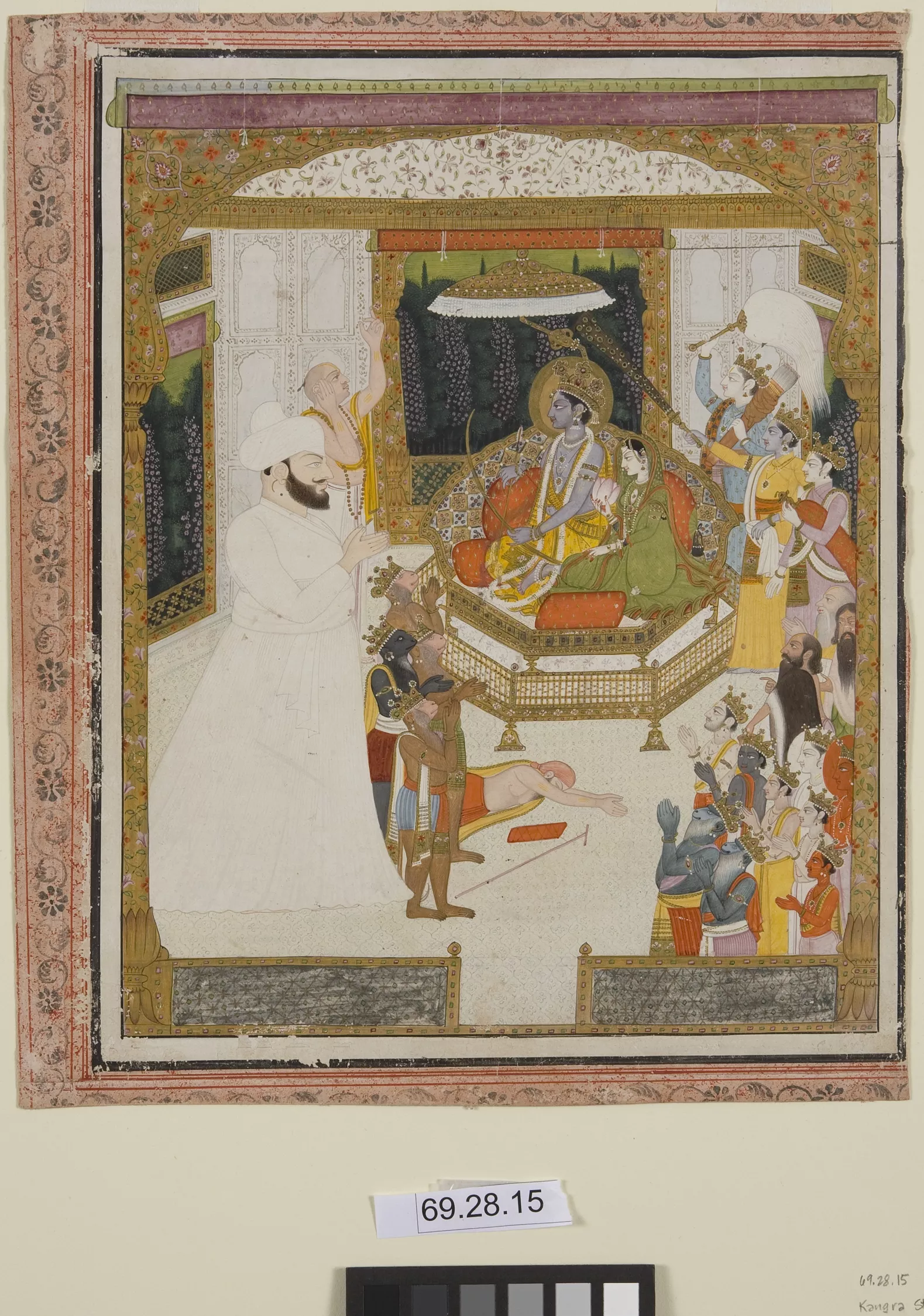Exhibit
Creation Date
1750
Height
25 cm
Width
20 cm
Medium
Genre
Description
This scene depicts the return of Rama and Sita from exile as narrated in the the Hindu epic, The Ramayana. A recurring theme in this image (found in many Indian works) is the idea of a divine king (chakravartin). From the time King Ashoka erected the divine pillars (axis mundi) in the third century BCE, Indian society has viewed rulers as divine kings that maintain order in their kingdoms (Mitter 14). By placing Jagat Prakash alongside Rama and Sita, the artist depicts a pious yet powerful ruler.
This scene illustrates an important episode from the Hindu epic Ramayana. In this epic tale, Rama and Sita, who lean against the red-cushioned throne, return to the capital city after spending fourteen years in exile. They are accompanied by monkeys and bears, the friends who helped them survive. Rama can be identified by the bow he carries and by the nimbus which encircles his head. Sita sits by Rama and holds a lotus flower, a symbol of creation. In front of the divine couple stands the royal priest, left hand up-raised, and the Pahari ruler of Sirmur, Raja Jagat Prakash (r. 1770-1789). The latter is dressed in a white jama and turban; he prays, hands clasped (Vajrā cā rya 180). Jagat Prakash’s larger-than-life dimensions (as evidenced by the relatively small size of Rama and Sita) exemplify the stylistic use of proportion to denote hierarchial status; he is portrayed as larger than the gods, symbolizing his divine rule.
Because of its strong local character and cultural significance, this work does not, at first, seem to have a direct connection with Romantic culture or aesthetics. The local Pahari style is evident in the bright floral patterns that adorn Rama and Sita’s canopy and throne. Additionally, the inclusion of mythological characters—gods and goddesses, monkeys and bears—resembles traditional Indian art that focused on depicting traditional mythology rather than real events. Finally, Vajrā cā rya describes Sirmur as a relatively isolated region, untouched by the aesthetics of Mughal and European conquerors (171). However, certain aspects of the image question its status as a "pure" representation of traditional Indian style. For example, the stark white color of Raja Jagat Prakash’s clothes and the niched structure of the windows (similar to niches present on the Taj Mahal) suggest a Mughal influence. As art historian Daniel Ehnbom articulates, the tendency to strictly divide the Rajput and Mughal styles may be subverted by evidence which suggests that much of Mughal art was derived from pre-Akbar, indigenous Indian artwork (Ehnbom 189). Consequently, despite the isolation of the Pahari region, the visual evidence of Mughal influence suggests a continuity and hybridity of artistic traditions among Indian regions—a fluid interchange of influences that later manifested itself in the hybridity of British and Indian artistic representations.
Locations Description
Now the state of Hiamachal Pradesh, Sirmur was situated among the Punjab hills between the Indus and the Ganges rivers. Located at the base of the Himalayas, Sirmur was also surrounded by mountains, a natural boundary that provided relative protection from the conquering Mughals and Europeans. When India came under British rule, Sirmur became a princely state whose rulers were allowed to govern through their own local laws and structures. Despite the centralization of government after the India Act of 1784, Sirmur continued to enjoy relative freedom from British law (Bayly).
The East India Company was formed to trade with East and Southeast Asia and India and was instituted by royal charter on Dec. 31, 1600. Although it started as a monopolistic trading company, it soon became involved in politics and acted as an instrument of British imperialism in India from the early eighteenth century to the mid-nineteenth century. The company was founded with the hope of dominating the East Indian spice trade. This trade had been a monopoly of Spain and Portugal until the defeat of the Spanish Armada in 1588 gave England the opportunity to appropriate the lucrative market.
Accession Number
69.28.15
Additional Information
Bibliography
Bayly, C. A. Indian Society and the Making of the British Empire. Cambridge: Cambridge UP, 1990. Print.
Chandra, Moti. The Technique of Mughal Painting. Lucknow: U. P. Historical Society, 1949. Print.
Chandra, Pramod. Indian Miniature Painting; the Collection of Earnest C. and Jane Werner Watson. Madison: Elvehjem Art Center, University of Wisconsin; distributed by U of Wisconsin P, 1971. Print.
Ehnbom, J. Daniell “ ‘Passionate Delineation and the Mainstream of Indian Painting’: The Mughal Style and the Schools of Rajasthan.” Rethinking Early Modern India. Ed. Richard B. Barnett. New Delhi: Manohar, 2002. Print.
Mitter, Partha. Indian Art. Oxford: Oxford UP, 2001. Print.
Vajrā cā rya, Gautamavajra. Watson Collection of Indian Miniatures at the Elvehjem Museum of Art: A Detailed Study of Selected Works. Madison: Elvehjem Museum of Art, 2002. Print.

